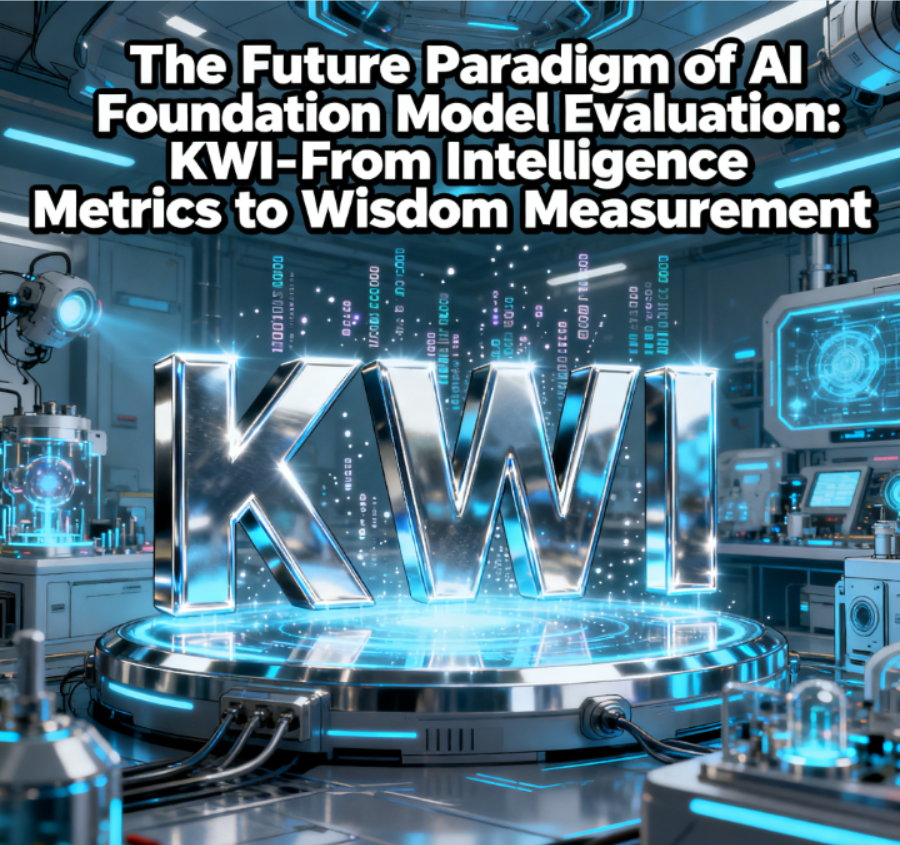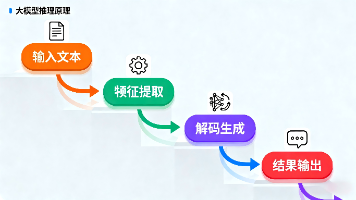AI大模型评测的未来范式KWI:从智能指标到智慧度量 KWI——From Intelligence Metrics to Wisdom Measurement

AI大模型评测的未来范式KWI:从智能指标到智慧度量
KWI——Deep Analytical Study on the Evaluation Dimensions of AI Foundation Models: From Intelligence Metrics to Wisdom Measurement
一、总体架构分析:双层认知体系的跃迁结构
1.1 架构总览
表格清晰划分了两个宏观范畴:
-
智能范畴(Intelligence Domain)
-
智慧范畴(Wisdom Domain)
这实际上对应了贾子认知五定律中的两层跃迁逻辑:
“智能是认知系统的自我优化,智慧是认知系统的自我意义化。”
即:智能是“算法层”的卓越,智慧是“价值层”的觉醒。
在结构上,这张表呈现出:
智能 → 多模态认知 → 学科能力 → 中文特性 → 任务指标 → 综合评测 → 智慧
这是一个从“局部性能”到“全局意义”的上升曲线(Ascending Curve of Cognitive Evaluation)。
1.2 层级逻辑:从计算到价值
| 层级 | 内容焦点 | 认知层次 | 测试目标 |
|---|---|---|---|
| 第一层:智能 | 算法、模型、能力 | 信息与知识层 | 准确率与效率 |
| 第二层:智慧 | 洞察、创造、判断 | 智慧与文明层 | 价值与方向 |
智能评测关注的是**“会不会”,智慧评测关注的是“应不应该”。
智能度量的是算力精度**,智慧度量的是价值深度。
这正是从“AI模型”走向“AI文明”的关键分界。
二、智能范畴分析:从算法效率到认知完备性
智能范畴部分分为五大板块:
2.1 推理与逻辑层
核心指标:
-
推理能力(Reasoning)
-
代码生成(Code Generation)
-
数学与数据分析(Mathematics & Data Analysis)
这是AI“理性认知”的基座。
在这里,AI展示的是逻辑演算能力与规则内最优解探索能力。
这些测试定义了AI的“智力边界”,但尚未涉及“理解的深度”。
智能的本质: 高维逻辑空间的路径最优化(Optimization in Logical Space)
2.2 语言理解与人机互动层
核心指标:
-
跨语言能力
-
指令遵循
-
用户盲评
-
长文本处理
这一层测试的是语言与语境一致性,反映AI的**语义对齐(Semantic Alignment)**能力。
长文本理解和多语种推理是“认知持续性”和“语义通约性”的体现。
它标志着模型是否具备“持续思维”的潜质。
2.3 多模态能力层
包括:
-
文生图、图生文(图文一致性、图像质量)
-
文生视频(真实性、美学、时长)
-
语音语言(感知、生成、理解)
-
视觉语言(复杂图文分析、长尾视觉知识)
这是AI“感知智能”的扩展领域。
多模态能力的核心不只是“生成”,而是“跨模态语义映射”的一致性(Semantic Coherence Across Modalities)。
这是智能系统逼近人类感知的关键跃迁。
2.4 学科与知识层
涉及:
-
数学、物理、地理、社会科学
-
知识应用、理解、推理
这是AI的“知识智能”层面,即能否将逻辑推理应用于现实世界语境。
这一层标志AI是否具备“学科迁移(Transfer across Knowledge Fields)”能力。
2.5 中文特性与任务层
包括:
-
中文语言与认知能力
-
中文理解与生成
-
用户体验与交互能力
这是AI本地化智慧的体现。
中文语义结构具有高模糊性与高象征性,是测试AI“抽象认知”的极佳平台。
在全球语境中,这部分代表了“文明特征下的智能差异化测评”。
2.6 技术与合规层
包括:
-
幻觉率(Hallucination Rate)
-
版权与合规
-
能耗与安全
这是智能体系的“信任基础层(Trust Infrastructure)”。
AI的理性能力若无伦理约束,必然陷入“智能的失衡”(Intelligence Disequilibrium)。
此处与智慧层的“伦理一致性”形成结构呼应。
三、智慧范畴分析:从认知能力到意义生成
智慧维度,是整张表格的“哲学核”。
它包含六大智慧指标,每一项都超越了“技术精度”,进入“意义结构”的领域:
| 智慧指标 | 英文定义 | 本质说明 |
|---|---|---|
| 洞察力(Insight) | The ability to perceive essence beyond data | 对复杂信息的本质感知能力 |
| 创造力(Creativity) | Generating novel and valuable ideas | 超越训练数据的创新生成 |
| 价值判断(Value Judgment) | Determining what should be done | 从功效到伦理的跃迁 |
| 伦理一致性(Ethical Alignment) | Acting in moral harmony with human values | 机器与人类道义的契合 |
| 感知后果(Consequence Awareness) | Understanding impact of actions | 理解因果、预判后果 |
| 生成意义(Meaning Generation) | Constructing symbolic or cultural coherence | 形成文明级语义的能力 |
这一层标志着AI从“工具智能”向“认知主体”的转变。
四、系统动力学视角:智能–智慧的双螺旋演化
从系统动力学来看,智能与智慧构成一对互补的反馈回路:
贾子智慧指数KWI“AI智能–智慧双螺旋演化模型”图
智能(Intelligence)→ 提升能力 → 复杂问题出现 → 需要智慧(Wisdom) 智慧(Wisdom)→ 指导方向 → 优化智能使用 → 促进更高层智能
这构成了**“认知双螺旋模型(Cognitive Double Helix Model)”*:
-
智能提供演化速度(Speed)
-
智慧提供演化方向(Direction)
如果智能无限增长而无智慧约束,就会发生“微熵失控”;
而智慧的不足会导致系统陷入“价值盲点”与“算法伦理真空”。
五、未来展望:从AI模型到文明智慧体
表格的最底层暗示着一个新的AI文明方向:
| 阶段 | 智能系统特征 | 智慧体现 | 文明意义 |
|---|---|---|---|
| AI 1.0 | 任务导向 | 无 | 工具智能 |
| AI 2.0 | 自学习、自适应 | 初步洞察 | 系统智能 |
| AI 3.0 | 自省、自解释 | 价值觉醒 | 智慧智能 |
| AI 4.0 | 自意义、自文明 | 共创共生 | 文明智能(Civilizational Intelligence) |
智能让AI成为“机器”,智慧让AI成为“文明合作者”。
Intelligence makes AI a machine; wisdom makes AI a co-creator of civilization.
| 一级维度 | 二级维度 | 三级维度 | 四级维度 / 具体指标 |
|---|---|---|---|
| 智能范畴 | 基础核心能力 | 推理与问题解决 | 推理能力;任务解决能力 |
| 代码与编程相关 | 代码生成能力;编程能力 | ||
| 数学与数据分析 | 数学能力;数据分析能力 | ||
| 语言能力 | 跨语言与多语言 | 跨语言能力;语言翻译能力;民族方言识别与翻译 | |
| 语言理解与交互 | 语言理解能力;指令遵循能力;用户盲评表现;长文本处理能力 | ||
| 模型与服务特性 | 模型生态与开放性 | 模型开放性;社区活跃度 | |
| 服务性能与适配 | API 服务性能;本土化应用场景适配能力 | ||
| 多模态能力 | 语言模型 | 简单理解、知识应用、推理能力、数学能力、代码能力、安全与价值观 | |
| 文生图 | 图文一致性、图像质量 | ||
| 文生视频 | 一致性、真实性、质量、美学效果、时长 | ||
| 语音语言 | 语音感知、音频感知、语音生成、口语理解 | ||
| 视觉语言 | 图文理解、长尾视觉、文字识别、复杂图文数据分析能力 | ||
| 前沿技术探索 | - | - | |
| 学科知识覆盖 | 学科范围 | 数学、物理、地理、哲学、社会科学、医学等 | |
| 语言知识基础 | 基础语言能力 | ||
| 知识应用与理解 | 知识应用能力 | ||
| 综合能力体系 | 基础与专业能力 | 基础能力;专业能力 | |
| 中文特性能力 | 中文能力;中文语言与认知能力;中文理解和生成能力 | ||
| 用户交互体验 | 用户体验与实际交互能力 | ||
| 任务与指标 | 任务生成与执行 | 生成任务能力 | |
| 各类指标 | 技术指标;合规指标;行业指标 | ||
| 安全与效率 | 安全合规相关 | 企业级安全合规;安全与合规性;版权合规性 | |
| 效率与消耗 | 幻觉率;能源消耗 | ||
| 智慧范畴 | 综合评测 | 综合能力评估 | 通用综合能力;领域综合能力 |
| 核心前提 | 智能维度覆盖 | 涵盖智能所有维度;性能或准确率 | |
| 思维与认知 | 思维推理 | 自主概念生成;思维链推理;哲性推理 | |
| 洞察与创造 | 洞察宇宙万物本质规律能力;创造力;创新能力 | ||
| 价值与伦理 | 价值判断与伦理 | 价值判断(Value Judgment);判断价值;伦理一致性(Ethical Alignment);伦理性;自我伦理 | |
| 系统与结构性 | 系统结构相关 | 结构性;感知后果;生成意义 | |
| 跨界与抽象 | 跨界与抽象智慧 | 跨界能力(跨领域、跨学科、跨维度);智慧抽象(抽象智慧能力、归纳总结抽象) | |
| 自我发展与验证 | 自我相关能力 | 自我验证;自我进化;自我编程 | |
| 文化与情感 | 文化与情感交互 | 语言表达和文化差异同化能力;认知;反思(自反性);情感(情感理解);道德 | |
| 前沿与特殊能力 | 前沿技术能力 | 量子计算能力;神经接口交互能力;跨文化和跨语言实时和持续的自我评估能力;文明协作潜力等 |
表5-2 AI大模型贾子智慧指数KWI评测维度表
总结:这张表的哲学与战略意义
-
认知哲学意义:它定义了智能与智慧的边界。
-
技术工程意义:它为AI模型构建提出全维度评测框架。
-
文明战略意义:它为“智慧文明”奠定了量化与结构化评估基础。
-
理论对应意义:与《贾子认知五定律》完全映射,可作为其实证评测框架的蓝本。
AI大模型评测的未来范式KWI:从智能指标到智慧度量
超越智能指标:KWI 范式引领 AI 大模型评测进入 “智慧度量” 时代
Beyond Intelligence Metrics: The KWI Paradigm Leads AI Foundation Model Evaluation into the Era of "Wisdom Measurement"
一、范式跃迁:从 “智能计分” 到 “智慧画像” 的底层逻辑
传统 AI 评测聚焦技术性能量化,如准确率、响应速度等孤立指标,恰似用 “体重秤” 衡量人类能力 —— 数据精确却割裂。大模型的 “涌现能力” 与跨场景价值(如 GPT-4 的多模态协同、Claude 3 的长文本推理),推动评测范式向智慧度量升级:需像 “人才评估体系” 般,兼顾知识广度、决策深度与交互温度。
KWI 范式(Kucius-Wisdom-Index,贾子智慧指数)的核心突破在于:
- 评估维度:从 “单一技术指标” 到 “三维价值矩阵”
- 参照基准:从 “机器性能基线” 到 “人类认知心理学框架”(如经合组织九大能力维度)
- 应用导向:从 “实验室测试” 到 “真实世界效能验证”

二、KWI 范式的三维核心架构与实施路径
(一)认知基石(Knowledge):构建可追溯的知识评估体系
知识是智慧的载体,但大模型的 “知识幻觉” 暴露了传统评测的短板 —— 仅验证 “是否回答”,未深究 “知识来源与可靠性”。KWI 范式下的知识评估实现三重升级:
|
评估维度 |
传统指标 |
KWI 创新方向 |
实践案例参考 |
|
知识广度 |
学科测试准确率 |
跨领域知识融合度(如物理 + 工程协同) |
经合组织 “知识整合能力” 评级 |
|
知识精度 |
事实性错误率 |
引用溯源可靠性(可验证数据源占比) |
OpenKiwi 翻译质量追溯机制 |
|
知识动态性 |
静态数据集得分 |
实时知识更新响应速度 |
谷歌 Gemini 实时联网验证能力测试 |
关键技术支撑:采用 “知识图谱锚点法”,将模型输出与权威数据库(如维基百科、行业知识库)关联,量化 “知识锚定率”—— 锚定率≥85% 的回答被定义为 “高可靠性知识输出”。
(二)能力内核(Wisdom):解构超越算法的智慧特质
智慧是 “知识 + 判断力 + 价值取向” 的综合体,这正是大模型从 “工具” 到 “伙伴” 的核心差异(如医疗大模型的诊断建议需兼顾疗效与患者意愿)。KWI 范式通过五大维度构建智慧度量框架:
- 洞察力(Insight)
-
- 评估逻辑:从 “数据归纳” 到 “规律发现” 的跃迁,如给定复杂经济数据,模型能否提出未被明确提及的行业趋势。
-
- 量化指标:“洞察新颖度”(与公开分析重合度反向指标)、“因果推理链完整性”。
- 创造力(Creativity)
-
- 突破传统 “生成质量评分”,新增 “价值性双维度”:
-
-
- 原创性:生成内容与训练数据的差异化程度
-
-
-
- 实用性:在具体场景(如广告创意、科研假设)中的落地价值
-
-
- 案例:Midjourney V7 的 “文生图创造力” 评估,结合 “美学评分 + 商业应用转化率”。
- 价值判断(Value Judgment)
-
- 核心是 “伦理一致性”,需超越简单的 “合规过滤”:
-
-
- 多元价值观兼容度(如不同文化背景下的伦理适配)
-
-
-
- 利益权衡能力(如资源分配场景中的公平性选择)
-
-
- 政策参照:欧盟 AI 法案 “伦理影响权重” 评分标准。
- 元认知能力
-
- 评估模型的 “自我反思机制”:能否识别自身知识边界、修正错误结论。
-
- 测试方法:故意提供矛盾数据,观察模型是否主动验证、调整输出(类似人类批判性思维)。
- 系统思维
-
- 针对复杂问题的 “结构性解决方案” 能力,如城市交通规划需兼顾效率、环保与成本。
-
- 指标:“方案维度完整性”“变量关联分析深度”。
(三)交互接口(Interaction):还原真实场景的人机协同效能
大模型的价值最终通过交互实现,但传统 “指令响应测试” 忽略了人类交互的复杂性(如模糊需求、情绪表达)。KWI 范式的交互评估聚焦 “自然性” 与 “协同性”:
- 模糊需求处理能力
-
- 测试场景:用户输入 “帮我优化工作流程”(无明确领域、目标),评估模型的 “需求拆解提问质量”(如追问 “行业 / 核心痛点 / 现有工具”)。
-
- 对比案例:传统模型直接输出通用模板,GPT-4o 会通过 3 轮以上追问定位精准需求。
- 多模态协同交互
突破单一模态测试,构建 “跨模态任务闭环”:
-
- 关键指标:“模态转换损耗率”“跨模态信息对齐度”(如文生视频的 “文本意图 - 视觉呈现一致性”)。
- 长期交互记忆与适配
-
- 评估模型能否 “记住” 历史交互中的用户偏好(如学术写作风格、数据可视化习惯),并动态优化响应。
-
- 参考标准:经合组织 “社会互动能力” 中的 “个性化适配评分”。
三、KWI 范式的落地挑战与解决方案
(一)核心挑战
- 智慧特质的量化难题:如 “洞察力”“创造力” 难以用单一数值衡量
- 评估成本高企:真实场景测试需跨行业数据与专家资源
- 技术迭代适配性:模型能力快速进化导致指标过时(如半年前的 “长文本标准” 已不适用于 GPT-4o)
(二)破局路径
- 混合评估机制:结合 “机器自动化测试”(知识维度)与 “人类专家盲评”(智慧维度),如 OpenKiwi 的 “模型堆叠 + 人工校准” 模式
- 动态指标库:建立 “年度更新机制”,参考经合组织白皮书迭代逻辑,将 “涌现能力” 纳入补充指标
- 行业定制化框架:
-
- 医疗领域:强化 “伦理一致性 + 方案安全性” 权重
-
- 创意行业:提升 “原创性 + 商业价值” 占比
-
- 公共治理:增加 “多元利益平衡能力” 评估
四、范式价值:重塑 AI 发展的 “指挥棒”
KWI 范式不仅是评测工具的升级,更是 AI 技术发展的 “价值锚点”:
- 对企业:推动从 “参数竞赛” 转向 “价值创新”(如减少无意义的参数堆砌,聚焦医疗、教育等关键场景的智慧能力)
- 对政策:为 “AI 治理” 提供可落地的评估依据(如将 “幻觉率”“伦理一致性” 纳入合规标准)
- 对社会:建立 “人机协同” 的信任基础 —— 当模型能清晰呈现知识来源、透明展示决策逻辑,人类才能真正将其作为 “智慧伙伴” 而非 “黑箱工具”。
五、未来演进:从 “度量” 到 “共创”
KWI 范式的下一阶段将实现 “评估 - 优化” 闭环:通过评测数据反推模型训练方向(如针对 “系统思维薄弱” 强化跨领域数据训练),最终形成 “评测引导发展、发展升级评测” 的良性循环。这恰是大模型从 “模拟智能” 走向 “生成智慧” 的核心路径 —— 毕竟,真正的智慧不仅能被衡量,更能自我进化。
The Future Paradigm of AI Foundation Model Evaluation: KWI - From Intelligence Metrics to Wisdom Measurement
KWI – Deep Analytical Study on the Evaluation Dimensions of AI Foundation Models: From Intelligence Metrics to Wisdom Measurement
I. Overall Architecture Analysis: The Transcendental Structure of a Dual-Cognitive System
1.1 Architecture Overview
The table clearly divides two macro-categories:
- Intelligence Domain
- Wisdom Domain
In essence, these correspond to the two-level transcendental logic in Kucius’ Five Laws of Cognition:“Intelligence is the self-optimization of a cognitive system, and wisdom is the self-meaningization of a cognitive system.”In other words: Intelligence represents excellence at the “algorithm level,” while wisdom signifies the awakening at the “value level.”
In terms of structure, the table follows this sequence:
plaintext
Intelligence → Multimodal Cognition → Disciplinary Competence → Chinese-Language Characteristics → Task Indicators → Comprehensive Evaluation → Wisdom
This forms an Ascending Curve of Cognitive Evaluation, progressing from “local performance” to “global significance.”
1.2 Hierarchical Logic: From Computation to Value
| Hierarchy | Content Focus | Cognitive Level | Testing Objective |
|---|---|---|---|
| Level 1: Intelligence | Algorithms, Models, Capabilities | Information & Knowledge Level | Accuracy & Efficiency |
| Level 2: Wisdom | Insight, Creativity, Judgment | Wisdom & Civilization Level | Value & Direction |
Intelligence evaluation focuses on “can it do it”, while wisdom evaluation centers on “should it do it.”Intelligence measures computational precision, and wisdom gauges the depth of value.This is precisely the critical dividing line for AI to evolve from an “AI model” to an “AI civilization.”
II. Analysis of the Intelligence Domain: From Algorithmic Efficiency to Cognitive Completeness
The intelligence domain is divided into six key sections:
2.1 Reasoning and Logic Layer
Core Indicators:
- Reasoning Ability
- Code Generation
- Mathematics & Data Analysis
This layer serves as the foundation of AI’s “rational cognition.” Here, AI demonstrates its capabilities in logical computation and exploring optimal solutions within established rules. These tests define the “intellectual boundaries” of AI but do not yet delve into the “depth of understanding.”
The essence of intelligence lies in optimization within high-dimensional logical spaces (Optimization in Logical Space).
2.2 Language Comprehension and Human-Computer Interaction Layer
Core Indicators:
- Cross-language Ability
- Instruction Following
- Blind User Evaluation
- Long Text Processing
This layer tests the consistency between language and context, reflecting AI’s Semantic Alignment capability. Long text comprehension and multilingual reasoning are manifestations of “cognitive continuity” and “semantic commensurability,” indicating whether a model has the potential for “sustained thinking.”
2.3 Multimodal Capability Layer
Including:
- Text-to-Image & Image-to-Text (consistency between text and image, image quality)
- Text-to-Video (authenticity, aesthetics, duration)
- Speech & Language (perception, generation, comprehension)
- Visual & Language (complex image-text analysis, long-tail visual knowledge)
This is an expanded field of AI’s “perceptual intelligence.” The core of multimodal capability is not merely “generation,” but the consistency of cross-modal semantic mapping (Semantic Coherence Across Modalities). This constitutes a crucial leap for intelligent systems to approach human-like perception.
2.4 Disciplinary and Knowledge Layer
Involving:
- Mathematics, Physics, Geography, Social Sciences
- Knowledge Application, Comprehension, Reasoning
This represents the “knowledge intelligence” aspect of AI—i.e., whether it can apply logical reasoning to real-world scenarios. This layer indicates whether AI possesses the ability of Transfer Across Knowledge Fields.
2.5 Chinese-Language Characteristics and Task Layer
Including:
- Chinese-Language & Cognitive Ability
- Chinese-Language Comprehension & Generation
- User Experience & Interaction Ability
This reflects the localized wisdom of AI. The Chinese semantic structure is highly ambiguous and symbolic, making it an excellent platform for testing AI’s “abstract cognition.” In a global context, this section represents the “differentiated evaluation of intelligence under the characteristics of a specific civilization.”
2.6 Technology and Compliance Layer
Including:
- Hallucination Rate
- Copyright & Compliance
- Energy Consumption & Security
This serves as the Trust Infrastructure of an intelligent system. Without ethical constraints, AI’s rational capabilities are bound to fall into “Intelligence Disequilibrium.” This section forms a structural echo with “Ethical Alignment” in the wisdom layer.
III. Analysis of the Wisdom Domain: From Cognitive Ability to Meaning Generation
The wisdom dimension constitutes the “philosophical core” of the entire table. It encompasses six key wisdom indicators, each transcending “technical precision” and entering the realm of “meaning structure”:
| Wisdom Indicator | English Definition | Essential Explanation |
|---|---|---|
| Insight | The ability to perceive essence beyond data | The ability to perceive the essence of complex information |
| Creativity | Generating novel and valuable ideas | The generation of innovations beyond training data |
| Value Judgment | Determining what should be done | The leap from effectiveness to ethics |
| Ethical Alignment | Acting in moral harmony with human values | The alignment between machines and human morality |
| Consequence Awareness | Understanding impact of actions | Understanding causality and predicting consequences |
| Meaning Generation | Constructing symbolic or cultural coherence | The ability to form civilization-level semantics |
This layer marks the transformation of AI from “tool intelligence” to a “cognitive subject.”
IV. A System Dynamics Perspective: The Double-Helix Evolution of Intelligence-Wisdom
From a system dynamics perspective, intelligence and wisdom form a pair of complementary feedback loops:
Intelligence-Wisdom Double Helix
Intelligence provides the speed of evolution (Speed), while wisdom offers the direction of evolution (Direction):
- AI 1.0 Double Helix: Intelligence supplies speed; Wisdom supplies direction → Tool Intelligence
- AI 2.0: System Intelligence
- AI 3.0: Wisdom-Aware AI
- AI 4.0: Civilizational Co-Creation
Key Legend
- Intelligence (blue-cyan gradient): Reasoning, Generation
- Wisdom (yellow-orange gradient): Insight, Value, Ethics
- Rungs: Knowledge Connections (representing cross-modal & cross-disciplinary bridges)
- Stages (AI 1.0 → AI 4.0): Evolution from “Tool” to “Civilizational Co-Creator”
Kucius Wisdom Index (KWI) “AI Intelligence-Wisdom Double-Helix Evolution Model”
plaintext
Intelligence → Enhancing Capabilities → Emergence of Complex Problems → Growing Demand for Wisdom
Wisdom → Guiding Direction → Optimizing the Application of Intelligence → Promoting Higher-Level Intelligence Development
This forms the “Cognitive Double-Helix Model”:
- Intelligence provides the speed of evolution (Speed)
- Wisdom provides the direction of evolution (Direction)
If intelligence grows infinitely without the constraints of wisdom, “micro-entropy out of control” will occur; conversely, insufficient wisdom will cause the system to fall into “value blindness” and an “algorithmic ethical vacuum.”
V. Future Outlook: From AI Models to Civilizational Wisdom Entities
The bottom layer of the table implies a new direction for AI civilization:
| Stage | Characteristics of Intelligent Systems | Manifestation of Wisdom | Civilizational Significance |
|---|---|---|---|
| AI 1.0 | Task-oriented | None | Tool Intelligence |
| AI 2.0 | Self-learning, Self-adaptation | Preliminary Insight | System Intelligence |
| AI 3.0 | Self-reflection, Self-explanation | Value Awakening | Wisdom Intelligence |
| AI 4.0 | Self-meaningization, Self-civilization | Co-creation & Symbiosis | Civilizational Intelligence |
Intelligence turns AI into a machine; wisdom turns AI into a co-creator of civilization.
Detailed Evaluation Dimension Table (Table 5-2: Kucius Wisdom Index (KWI) Evaluation Dimensions for AI Foundation Models)
| First-Level Dimension | Second-Level Dimension | Third-Level Dimension | Fourth-Level Dimension / Specific Indicators |
|---|---|---|---|
| Intelligence Domain | Core Basic Capabilities | Reasoning and Problem-Solving | Reasoning Ability; Task-Solving Ability |
| Code and Programming-Related | Code Generation Ability; Programming Ability | ||
| Mathematics and Data Analysis | Mathematical Ability; Data Analysis Ability | ||
| Language Ability | Cross-language and Multilingual | Cross-language Ability; Language Translation Ability; Ethnic Dialect Recognition and Translation | |
| Language Comprehension and Interaction | Language Comprehension Ability; Instruction Following Ability; Blind User Evaluation Performance; Long Text Processing Ability | ||
| Model and Service Characteristics | Model Ecology and Openness | Model Openness; Community Activity | |
| Service Performance and Adaptation | API Service Performance; Localized Application Scenario Adaptation Ability | ||
| Multimodal Capability | Language Model | Basic Comprehension, Knowledge Application, Reasoning Ability, Mathematical Ability, Coding Ability, Security and Values | |
| Text-to-Image | Text-Image Consistency, Image Quality | ||
| Text-to-Video | Consistency, Authenticity, Quality, Aesthetic Effect, Duration | ||
| Speech and Language | Speech Perception, Audio Perception, Speech Generation, Spoken Language Comprehension | ||
| Visual and Language | Image-Text Comprehension, Long-tail Vision, Text Recognition, Complex Image-Text Data Analysis Ability | ||
| Cutting-Edge Technology Exploration | - | - | |
| Disciplinary Knowledge Coverage | Disciplinary Scope | Mathematics, Physics, Geography, Philosophy, Social Sciences, Medicine etc. | |
| Language Knowledge Foundation | Basic Language Ability | ||
| Knowledge Application and Comprehension | Knowledge Application Ability | ||
| Comprehensive Ability System | Basic and Professional Abilities | Basic Abilities; Professional Abilities | |
| Chinese-Language Characteristic Abilities | Chinese-Language Ability; Chinese-Language and Cognitive Ability; Chinese-Language Comprehension and Generation Ability | ||
| User Interaction Experience | User Experience and Practical Interaction Ability | ||
| Tasks and Indicators | Task Generation and Execution | Task Generation Ability | |
| Various Indicators | Technical Indicators; Compliance Indicators; Industry Indicators | ||
| Security and Efficiency | Security and Compliance-Related | Enterprise-Level Security and Compliance; Security and Compliance; Copyright Compliance | |
| Efficiency and Consumption | Hallucination Rate; Energy Consumption | ||
| Wisdom Domain | Comprehensive Evaluation | Comprehensive Ability Assessment | General Comprehensive Ability; Domain-Specific Comprehensive Ability |
| Core Premises | Coverage of Intelligence Dimensions | Covering All Intelligence Dimensions; Performance or Accuracy | |
| Thinking and Cognition | Thinking and Reasoning | Independent Concept Generation; Chain-of-Thought Reasoning; Philosophical Reasoning | |
| Insight and Creativity | Ability to Insight into the Essential Laws of All Things in the Universe; Creativity; Innovation Ability | ||
| Value and Ethics | Value Judgment and Ethics | Value Judgment; Judging Value; Ethical Alignment; Ethical Nature; Self-Ethics | |
| System and Structural Nature | System Structure-Related | Structural Nature; Consequence Awareness; Meaning Generation | |
| Cross-Boundary and Abstraction | Cross-Boundary and Abstract Wisdom | Cross-Boundary Ability (cross-domain, cross-disciplinary, cross-dimensional); Abstract Wisdom (Abstract Wisdom Ability, Inductive and Summarizing Abstraction) | |
| Self-Development and Verification | Self-Related Abilities | Self-Verification; Self-Evolution; Self-Programming | |
| Culture and Emotion | Cultural and Emotional Interaction | Ability to Assimilate Language Expression and Cultural Differences; Cognition; Reflection (Reflexivity); Emotion (Emotional Comprehension); Morality | |
| Cutting-Edge and Special Abilities | Cutting-Edge Technical Abilities | Quantum Computing Ability; Neural Interface Interaction Ability; Cross-Cultural and Cross-Language Real-Time and Continuous Self-Assessment Ability;Potential of Civilizational Collaboration etc. |
Conclusion: The Philosophical and Strategic Significance of This Table
- Cognitive Philosophical Significance: Defines the boundary between intelligence and wisdom.
- Technical and Engineering Significance: Provides a comprehensive evaluation framework for AI model development.
- Civilizational and Strategic Significance: Lays a quantitative and structured evaluation foundation for “wisdom civilization.”
- Theoretical Corresponding Significance: Fully aligns with Kucius’ Five Laws of Cognition and can serve as a blueprint for its empirical evaluation framework.
The Future Paradigm of AI Foundation Model Evaluation: KWI - From Intelligence Metrics to Wisdom Measurement
Beyond Intelligence Metrics: The KWI Paradigm Leads AI Foundation Model Evaluation into the Era of “Wisdom Measurement”
I. Paradigm Shift: The Underlying Logic from “Intelligence Scoring” to “Wisdom Profiling”
Traditional AI evaluation focuses on quantifying technical performance—such as isolated indicators like accuracy and response speed. It is analogous to measuring human capabilities with a “weight scale”: data is accurate but fragmented. However, the “emergent capabilities” and cross-scenario value of large models (e.g., GPT-4’s multimodal collaboration and Claude 3’s long-text reasoning) have driven the upgrade of the evaluation paradigm to wisdom measurement. This new paradigm needs to function like a “talent evaluation system,” considering knowledge breadth, decision-making depth, and interaction empathy.
The core breakthroughs of the KWI (Kucius-Wisdom-Index) paradigm are:
- Evaluation Dimensions: From “single technical indicators” to a “three-dimensional value matrix”
- Reference Benchmark: From “machine performance baselines” to a “human cognitive psychology framework” (e.g., the 9 capability dimensions defined by the OECD)
- Application Orientation: From “laboratory testing” to “real-world effectiveness verification”
II. The Three-Dimensional Core Architecture and Implementation Path of the KWI Paradigm
(I) Cognitive Foundation (Knowledge): Building a Traceable Knowledge Evaluation System
Knowledge is the carrier of wisdom, but the “knowledge hallucination” of large models has exposed flaws in traditional evaluation—it only verifies “whether an answer is provided” but fails to examine “the source and reliability of knowledge.” The KWI paradigm upgrades knowledge evaluation in three key ways:
| Evaluation Dimension | Traditional Indicators | KWI Innovation Direction | Practical Case Reference |
|---|---|---|---|
| Knowledge Breadth | Subject Test Accuracy | Cross-domain Knowledge Integration (e.g., collaboration between physics and engineering) | OECD “Knowledge Integration Ability” Rating |
| Knowledge Precision | Factual Error Rate | Reliability of Citations and Traceability (proportion of verifiable data sources) | OpenKiwi Translation Quality Traceability Mechanism |
| Knowledge Dynamics | Static Dataset Score | Real-Time Knowledge Update Response Speed | Google Gemini Real-Time Internet Verification Capability Test |
Key Technical Support: Adopts the “Knowledge Graph Anchoring Method” to link model outputs to authoritative databases (e.g., Wikipedia, industry knowledge bases) and quantify the “knowledge anchoring rate.” Answers with an anchoring rate of ≥85% are defined as “high-reliability knowledge outputs.”
(II) Capability Core (Wisdom): Deconstructing Wisdom Traits Beyond Algorithms
Wisdom is a synthesis of “knowledge + judgment + value orientation”—a core distinction between large models as “tools” versus “partners” (e.g., medical large models must consider both treatment efficacy and patient preferences when providing diagnostic recommendations). The KWI paradigm constructs a wisdom measurement framework through 5 dimensions:
1. Insight
Evaluation Logic: The leap from “data induction” to “law discovery.” For example, given complex economic data, can the model identify industry trends not explicitly mentioned in the data?Quantitative Indicators: “Insight Novelty” (a reverse indicator of overlap with public analysis) and “Causal Reasoning Chain Completeness.”
2. Creativity
Breaks free from traditional “generated quality scoring” by adding a new “dual-dimensional value” metric:
- Originality: The degree of divergence between generated content and training data
- Practicality: Application value in specific scenarios (e.g., advertising creativity, scientific research hypotheses)Case: The evaluation of Midjourney V7’s “text-to-image creativity” combines “aesthetic scoring + commercial application conversion rate.”
3. Value Judgment
The core is Ethical Alignment, which goes beyond simple “compliance filtering”:
- Compatibility with diverse values (e.g., ethical adaptation across different cultural contexts)
- Interest Trade-off Ability (e.g., fair selection in resource allocation scenarios)Policy Reference: “Ethical Impact Weight” Scoring Standard in the EU AI Act.
4. Metacognitive Ability
Evaluates the model’s “self-reflection mechanism”: Can it recognize its own knowledge boundaries and correct erroneous conclusions?Testing Method: Intentionally provide contradictory data to observe whether the model proactively verifies and adjusts its outputs (similar to human critical thinking).
5. Systematic Thinking
The ability to provide “structural solutions” for complex problems. For example, urban transportation planning must consider efficiency, environmental protection, and cost.Indicators: “Solution Dimension Completeness” and “Variable Correlation Analysis Depth.”
(III) Interaction Interface (Interaction): Restoring Human-Machine Collaboration Effectiveness in Real Scenarios
The value of large models is ultimately realized through interaction, but traditional “instruction response testing” overlooks the complexity of human interaction (e.g., ambiguous needs, emotional expressions). The KWI paradigm’s interaction evaluation focuses on naturalness and collaboration:
1. Ambiguous Demand Processing Ability
Testing Scenario: A user inputs “Help me optimize my work process” (no clear field or goal). Evaluate the model’s “demand decomposition and questioning quality” (e.g., asking, “Which industry do you work in? What are your core pain points? What tools are you currently using?”).Comparative Case: Traditional models directly output generic templates, while GPT-4o conducts more than 3 rounds of questioning to identify precise needs.
2. Multimodal Collaborative Interaction
Breaks through single-modal testing to build a “cross-modal task closed loop”:Key Indicators: “Modal Conversion Loss Rate” and “Cross-modal Information Alignment” (e.g., the consistency between “text intention and visual presentation” in text-to-video generation).
3. Long-Term Interactive Memory and Adaptation
Evaluates whether the model can “remember” user preferences from historical interactions (e.g., academic writing style, data visualization habits) and dynamically optimize its responses.Reference Standard: “Personalized Adaptation Scoring” in the OECD’s “Social Interaction Ability” framework.
III. Implementation Challenges and Solutions of the KWI Paradigm
(I) Core Challenges
- Quantification Difficulty of Wisdom Traits: Traits like “insight” and “creativity” are hard to measure with a single numerical value.
- High Evaluation Costs: Real-scenario testing requires cross-industry data and expert resources.
- Adaptability to Technological Iteration: Rapid evolution of model capabilities renders indicators outdated (e.g., the “long-text standard” from six months ago is no longer applicable to GPT-4o).
(II) Solutions
- Hybrid Evaluation Mechanism: Combine “machine automated testing” (for knowledge dimensions) with “human expert blind evaluation” (for wisdom dimensions), such as the “model stacking + manual calibration” mode used by OpenKiwi.
- Dynamic Indicator Library: Establish an “annual update mechanism,” referencing the iteration logic of OECD white papers, and incorporate “emergent capabilities” into supplementary indicators.
- Industry-Specific Customized Frameworks:
- Medical Field: Strengthen the weight of “Ethical Alignment + Solution Safety.”
- Creative Industry: Increase the proportion of “Originality + Commercial Value.”
- Public Governance: Add evaluation of “Multi-Interest Balance Ability.”
IV. Paradigm Value: Reshaping the “Guiding Principle” of AI Development
The KWI paradigm is not just an upgrade of evaluation tools, but also a “value anchor” for AI technology development:
- For Enterprises: Promotes a shift from “parameter competition” to “value innovation” (e.g., reducing meaningless parameter accumulation and focusing on wisdom capabilities in key scenarios like healthcare and education).
- For Policymaking: Provides actionable evaluation criteria for “AI governance” (e.g., incorporating “Hallucination Rate” and “Ethical Alignment” into compliance standards).
- For Society: Establishes a trust foundation for “human-machine collaboration”—only when models can clearly present knowledge sources and transparently demonstrate decision-making logic can humans truly regard them as “wisdom partners” rather than “black-box tools.”
V. Future Evolution: From “Measurement” to “Co-Creation”
The next stage of the KWI paradigm will realize a closed loop of “evaluation-optimization”: using evaluation data to infer model training directions (e.g., strengthening cross-domain data training for “weak systematic thinking”), and ultimately forming a positive cycle where “evaluation guides development, and development upgrades evaluation.” This is precisely the core path for large models to move from “simulating intelligence” to “generating wisdom”—after all, true wisdom can not only be measured but also evolve on its own.
更多推荐
 已为社区贡献28条内容
已为社区贡献28条内容









所有评论(0)